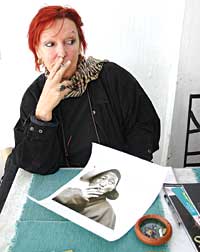 There may be a reason why Australian photographer and writer, Jill Gocher, was fascinated by the Khampa. They are both nomads.
There may be a reason why Australian photographer and writer, Jill Gocher, was fascinated by the Khampa. They are both nomads. Gocher has been living and working in Asian countries for the past 20 years, spending a lot of time in Indonesia-that vast archipelago of 15,000 islands which is a world in itself. But more recently she has discovered the Himalaya and its peoples.
Today, she divides her time between Singapore and Nepal, writing, photographing and exploring. The recurring theme in her work is of people and cultures which are struggling to survive against the relentless tide of soulless modernity. Says Jill: "Traditional values and lifestyles give meaning and balance to life, a fact that we in the West are slowly coming to realise."
Too often, though, the East is so busy trying to catch up with the West it doesn't realise what it is losing. This is where documentists like Jill Gocher come in, many times, to remind us of what is precious in our own societies. The Khampa are Tibet's "cowboys": exuberant, hard-working, family-oriented, and devoutly Buddhist. The historic kingdom of Kham was always "more Tibetan than Tibet" even though its people do not live within the territory of modern-day Tibetan Autonomous Region.
The Khampas earned a reputation as fearless guerrilla fighters in the anti-Chinese resistance after Tibet was occupied in the 1950s. Many Khampas were based in guerrilla camps in Mustang and carried out hit-and-run attacks on the plateau, until they were wiped out in a Royal Nepali Army action in 1975.
 "Every year, Kham is becoming less remote. Earlier only very few extremely determined people could go there," says Gocher. Since Kham is not a part of Tibet, tourists don't need permits and this makes it even more accessible to outsiders.
"Every year, Kham is becoming less remote. Earlier only very few extremely determined people could go there," says Gocher. Since Kham is not a part of Tibet, tourists don't need permits and this makes it even more accessible to outsiders. Gocher doesn't like to think that her portraits are of a dying people. "Yes, the spirit of the Khampa may be eroding, but this exhibition is a celebration of their dignity and deep values." The photographer has deliberately chosen black and white. "Colour is distracting, black and white forces us to focus on what is important: the interplay of light and shade and composition."
Gocher points to a picture of a child lama in the courtyard of a monastery in oblique light. "This came out well, it wasn't posed, I just happened to capture the moment when this gorgeous, precious little lama was walking across the light," she says. The black and whites are taken with Jill's 50-year-old Leica. "It is a very silent camera, and every photo is a meditation. The lightmeter is here," she says, tapping her head with a finger.
But the process of developing is not so old-fashioned. The pictures are scanned, edited on Photoshop through a digital process and turned back into bromide prints. This technique has allowed Jill to subtly insert colour where you least expect it amidst the light sepia: the surprising red tint of a coral on a horseman's ring, a red silk braid on the stylish hair of a Khampa in a fedora.
Ironically, it is through Jill Gocher's exhibition that the Khampas may be able to come a full circle to Mustang. Lamas from a monastery in Mustang will be performing at the inauguration on Friday and it is intriguing to think that some of them could actually be offspring of Khampas who once used to be based in Nepal's trans-Himalayan regions.
Khampa-Portraits of Eastern Tibet by Jill Gocher From 20 February 16, 2004 Siddhartha Art Gallery, 4218048


